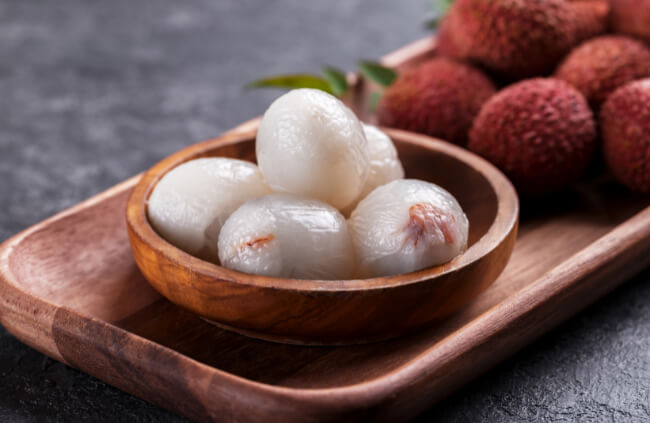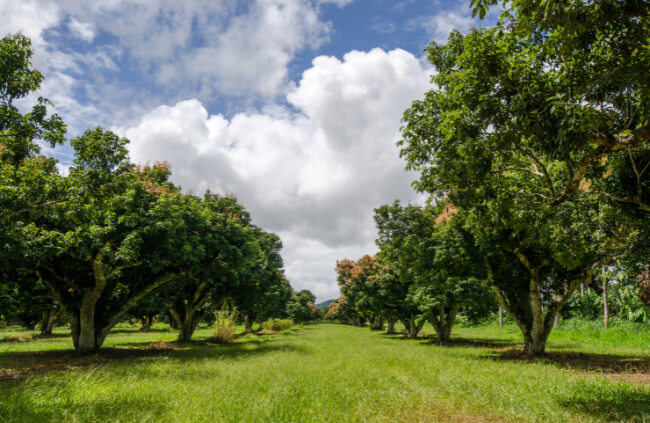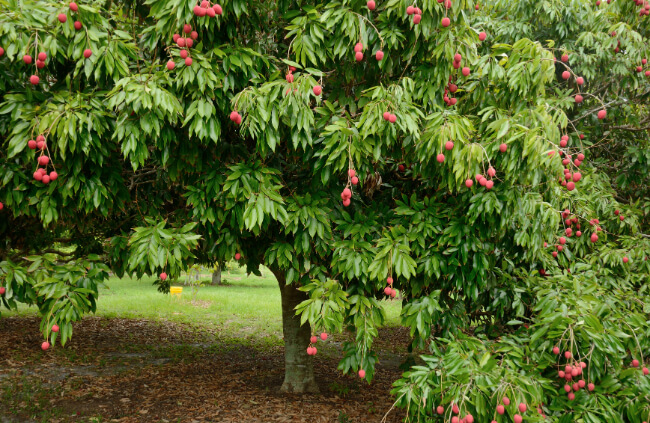Often known as the ‘king of fruits’, lychees date back to 1700 BC and originated from South China. Arriving in Australia in the 1870s with Chinese gold hunters, this subtropical fruit was given as a good luck charm and symbolised romance.
Australia now has the longest lasting season of producing lychees the world over, stretching from October to March. The most popular growing areas for lychee trees are in Queensland and NSW.
In our guide about the lychee tree, we’ll share a bit more about this fruit bearing evergreen tree and the varieties that have become well known in Australia. Learn how to propagate your own tree using seed, how to care for it once established, and also a bit more about lychee as a much loved edible treat.
More...

Family: | Sapindaceae |
|---|---|
Genus: | Litchi |
Species: | L. chinensis |
Origin: | Asia |
Common Names: | Lychee, litchi |
Location: | Outdoor |
Type: | Fruit tree |
Growth: | Up to 15 metres tall and wide |
Sun requirements: | Full sun |
Foliage Colour: | Green |
Flower Colour: | White, yellow, green |
Flowering: | Spring |
Edible Parts: | Inner flesh of the lychee fruit. The seed and rind are slightly toxic. |
Maintenance level: | Average |
Poisonous for pets: | No, as long as the fruit is ripe and the seed and rind have been removed. |
Introducing the Lychee Tree
The lychee fruit grows on trees that enjoy a subtropical or tropical climate. Litchi chinensis, commonly known as Lychee tree, is evergreen and can grow equally well in the ground or in a pot as long as it has full sun and protection from strong wind.
Although lychee trees can reach up to 15 metres in height in their natural setting, you can keep them at a more manageable height for your home garden with pruning.
Lychee Fruit
Lychee trees self-pollinate so one tree is all you need in order to produce fruit. You can usually start enjoying lychee fruit from 3 to 5 years after planting the tree. Fruit production is usually best and most generous by year 10 of the tree’s life.
The secret to the best fruit is ensuring the tree has cool enough night time temperatures for a few weeks. This ensures a good variety of male and female flowers.
Popular Lychee Varieties

There are many different varieties of lychee the world over. Here are some that are popular in Australia in particular.
- Baitaying Lychee - This variety produces fruit early in the season. The fruit is medium size and can be red or orange in colour. This type can be stored very well for later use.
- Bengal Lychee - This variety is what we think of as a classic lychee type. The fruit skin is bright red and it has a big seed. Bengal lychee is usually available from December to January. It can be difficult to find stock.
- Chompogo Lychee - This variety produces fruit later in the season. The fruit is medium to large in size, red, and grows on a tree that has a dome shape. You can leave the fruit on the tree for longer before picking.
- Erdon Lee Lychee - This variety produces fruit in the middle of or later in the season. The fruit is big and a dark red colour, with a skin that is wrinkled. The tree is quite large with spread out branches.
- Fay Zee Siu Lychee - This variety produces big fruit and has a sweet taste. The fruit has a green speckled effect on the skin. You can source this lychee type from November to December.
- Kwai Mai Pink Lychee - This variety was developed in Australia and is delicious for eating. The fruit is more round, has red skin with some orange as well, and produces a smallish seed. This type is available from November to February.
- Sah Keng Lychee - This is a Thai variety and is lovely to eat. The fruit is big, red in colour and produces a small seed. This lychee is available from December to January.
- Salathiel Lychee - This variety was developed in Australia. The fruit is small and has a bright red colour with skin that is smooth. You can source this variety from December to January.
- Souey Tung Lychee - This variety was the first lychee cultivated in Australia. Access to this particular type of lychee is becoming easier as it gains popularity. You are able to source the fruit from October to November.
- Wai Chee Lychee - This variety is a late fruiting kind. The fruit is round, is deep red, and has smooth skin. It’s known for being sweet and juicy. This variety grows particularly in South East Queensland and NSW.
How to Grow Lychee Trees in Australia
The easiest way to grow your own lychee tree is to start it from seeds. Your best chance of success is to use seed from a mature fruit. The single seed that you get from each fruit should ideally be round and smooth, and also large in size.
If the seed has a longer shape and looks shrivelled rather don’t use it. Aim to plant the seeds as quickly as possible as they will dry out within a few days. Once you have your chosen seeds, you’ll need to soak for 3 days in water.
Choose a pot that is at least 30 cm tall and fill it up with potting soil that is well-draining. Plant the seeds at a depth of 2.5 cm, and then put them somewhere warm and be sure to keep the soil moist.
Germination of the lychee seeds takes anywhere from one to four weeks. Once you see signs of new growth, you can move your pot to a place that gets part sun.
You’ll see quite rapid growth of the lychee tree during the first year but then it starts to slow down and it becomes more of a waiting process before you get to enjoy your first harvest of fruit.
Ideal Conditions for Planting Lychee Trees

Light and Climate Preference
Ultimately, lychees do enjoy full sun, but you’ll need to build up to this kind of light exposure. For the first few years, you can grow your lychee tree in part shade and over time, let it become used to full sun.


Get Your Free Guide:
Master Growing Australian Natives eBook
A Must Have Complete Guide for Every Australian Garden
Get Your Free Guide:
Master Growing Australian Natives eBook
A Must Have Complete Guide for Every Australian Garden
Lychee trees will need protection from frost and strong wind. They need features of a sub-tropical climate to help them produce male and female flowers.
Best Soil to Use
A lychee tree likes a slightly acidic soil. It should be well-draining and have lots of organic matter like compost or manure. If your garden soil is more alkaline, you could use pine bark or needles to adjust the soil to a more suitable level.
Temperature and Humidity
Although a lychee tree does like warm temperatures, it can also handle the cold quite well. In fact, the lychee tree needs sufficient cold temperature exposure for around 100 hours in the winter time in order to bloom in spring and produce fruit in summer. High humidity is also preferable for this tree.
Watering Schedule
While your lychee tree is establishing itself and during spring time, you should water it regularly to help with the development of fruit. For the younger trees, if the soil feels dry, that’s your cue to water.
If your lychee tree is in a pot, you’ll need to water it every day. For a more established tree, you can water once per week.
Fertiliser
You can feed your lychee tree once or twice while it’s going through the growing phase in spring and summer. A weak liquid fertiliser will be suitable.
Pruning Lychee Tree
You can help your lychee tree develop a strong centre by training it with pruning, starting when it’s young. You can trim off any side growth up to a metre in length.
How to Harvest and Store Lychee
The lychee fruit has a roundish shape, with skin that is reddish, bumpy, and inedible. The fruit’s flesh is white and milky looking, with a type of jelly texture. Lychees are sweet and the mouth feel is similar to a grape.
The lychee tree produces clusters of fruit that can bear as many as 50 at a time but first fruits can take between 3 to 5 years.
Harvesting Lychee
You can harvest lychee fruit between November and March. You’ll know it’s ready as the colour will change to pink or red. Harvest time can differ slightly as well as the skin colour depending on where you live and also the lychee variety.
We recommend harvesting in the morning to enjoy the sweetest fruit. Cut the fruit from the lychee tree in a bunch so that you don’t damage the lychee skin. Lychee fruit does not ripen once it’s been removed from the tree.

How to Store Lychee
Lychee fruit can be enjoyed frozen or fresh and has a variety of culinary uses from jams and sauces, to fruit salads and dishes with pork or duck. Fresh lychee fruit can be wrapped up in plastic and then stored in the fridge for up to 7 days.
You can store them at room temperature for up to 3 days, and if you opt to freeze them, you can store the fruit for up to 6 months.
If making your own jam is a passion, don't miss our comprehensive guide to growing gooseberry plants.
Lychee Tree Common Pests and Diseases
Mealybugs
Mealybugs are soft insects with an oval shape and waxy covering. They pierce and suck the sap of plants and are often found living in a colony. You might be dealing with a mealybug infestation if you see white and cotton-like clumps on your plant, a sticky honeydew substance, the appearance of ants, and black sooty mould.
The mealybugs feast on the plant sap and cause it to become weak. If the colony is big enough, you might notice that plant growth is slowing down and that the leaves start to drop.
Creating an organic and homemade treatment is simple. Mix a cup of rubbing alcohol with a litre of water and then add a few drops of dish soap. Pop into a spray bottle and then treat your entire tree, making sure that you spray it thoroughly.
Aphids
Aphids are tiny insects with soft bodies and operate in the same way that mealybugs do, sucking the sap from your tree. Smaller quantities of this pest usually don’t cause much damage but in the case of severe aphid infestation, the leaves on your tree might look curly and twisted.
The leaves could also be yellow and you might notice that the tree isn’t growing well. You can treat your tree using insecticidal soap, horticultural, or plant based oils like neem oil or canola.
If you make sure to cover the leaves of your lychee tree well, it should be effective as these treatments actually smother the aphids.
Spider Mites
Spider mites are sometimes also known as red spiders. They are really small so you might not even be able to see them. Evidence of spider mites are patterns of silver dots and webs on the leaves and stems of the lychee tree.
Check the underneath of the leaves and also the stem corners. A great way to reduce colonies of spider mites is to wipe down the tree leaves with a delicate cloth or you can use a strong spray of water to move them along.
Lychee Tree Frequently Asked Questions

When is a good time to repot my lychee tree?
You can repot your lychee tree every spring until it reaches a size that you are happy with. You can maintain it as a small tree by pruning the main growing branches each year which will create a small and bushy tree.
What is the best place to plant a lychee tree?
Lychee trees like space to grow so plant them away from other trees and a fair distance from your home. This is to ensure that they don’t become too shaded which will affect the lychee tree’s growth and fruit production.
Lychee trees don’t like to stand in water so if you want to help water drain away from the tree, you could plant it on a raised mound of soil.
Does the lychee tree have any medicinal uses?
Lychee fruit has been used to help ease swelling and pain. It’s also known to stimulate the body’s immune system with antioxidant properties.
What makes Australian lychees so great tasting?
Australian lychees are known to be some of the freshest in the world. This is because local producers don’t use sulphur dioxide to maintain the fruit’s skin colour. This means that our lychee fruit remains fresh, sweet, and juicy, but also looks more natural.
What are the health benefits of lychee fruit?
Lychees come with many health benefits. One serving of lychees has as much vitamin C as a small orange. Along with strawberries, lychees are high in antioxidants. They are medium GI and offer slow release energy, making it the ideal snack to maintain blood sugar levels.
What is the best fertiliser for lychee trees?
A fertiliser mixture that has around 8 percent nitrogen, 4 percent phosphorus, 8 percent potash, and 4 percent magnesium is great.
Looking for more trees to grow in your garden? Check out our comprehensive guide to growing persimmon trees in Australia.
Wrapping Up Our Lychee Tree Guide
Dreaming up all the delicious things you can make with lychee fruit is probably motivation enough to grow your own lychee tree. Think cocktails and desserts for your next gathering of family and friends, or simply enjoy the fruit fresh off the Lychee tree, as you savour the sweet and floral notes.
Published on July 27, 2023 by Maisie Blevins
Last Updated on September 20, 2025




